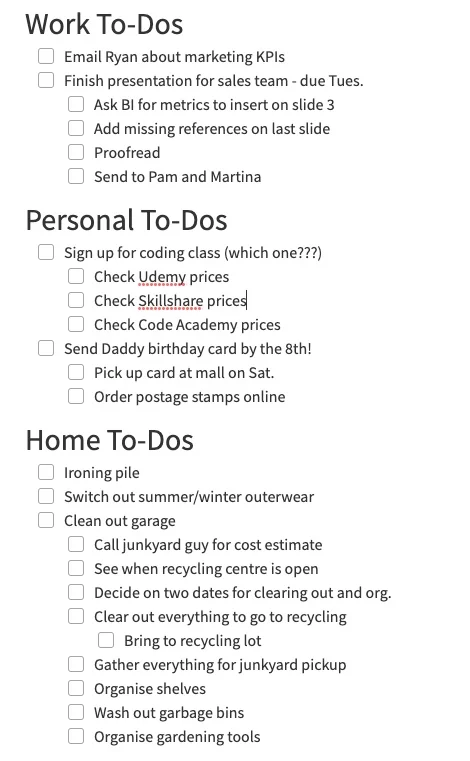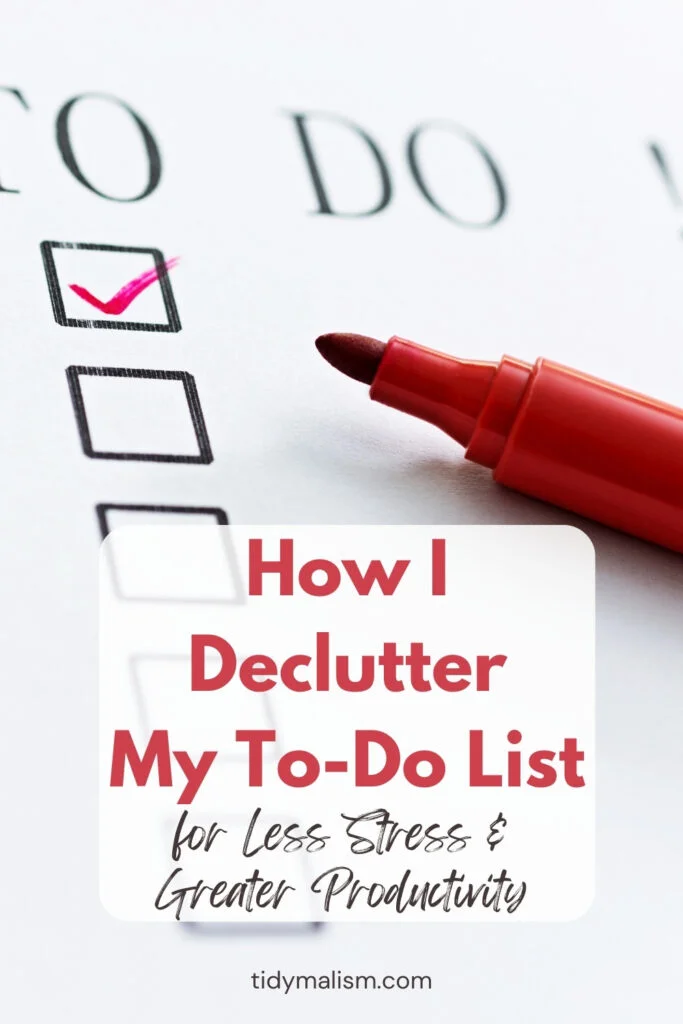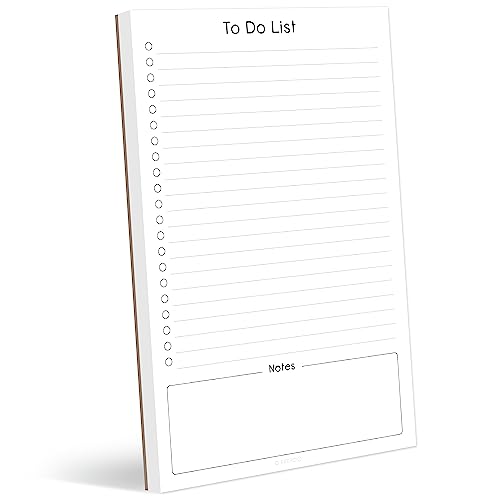Recently I developed an increasing sense of dread every time I looked at my to-do list. If yours is anything like mine was, it’s overflowing with tasks. Yet an endless list can be incredibly overwhelming, leading to a feeling of falling constantly behind, guilt, and stress. Ultimately, it can counter affect what you’re trying to get done because it lures you into procrastination instead of productivity. In this post, I want to share how I declutter my to-do list to turn it back into a powerful tool to stay organised both at home and at work.
Whether you keep your lists on paper or in a note-taking app like Devonthink, read on!
To-Do List Pitfalls and Why They Can Feel Overwhelming
When we have too many things on our to-do list, it’s easy to become paralysed by indecision and end up doing nothing at all. Or, we might start working on one task only to get sidetracked by another, and never actually finish anything.
Stress
It’s no secret that a lot of us are guilty of overstuffing our to-do lists. We add more and more tasks, thinking that we’ll get them all done at some point. But what we don’t realise is that an endless to-do list can actually lead to a lot of stress.
When we have too many things on our plate, it can become overwhelming and make it difficult to focus on any one thing. This leads us feeling like we’re not making any progress. The result? Frustration and stress.
Procrastination
Your to-do list is supposed to help you stay organised and on track with your goals. But when it’s overstuffed, it can also lead to procrastination. The sheer sight of a long to-do list can seem totally daunting, causing you to feel like you’ll never get any of it done. This has a way of ultimately leading procrastination, as you put off tackling items on your list because you feel like it’s just too much.
To avoid to-do stress and procrastination, it’s important to declutter your list on a regular basis. Break larger tasks down into smaller, more manageable chunks. Prioritise the most important items, and delegate or delete anything that isn’t absolutely essential. We’ll dive into this further below.
Why I Still Love Classic To-Do Lists
There are many benefits to keeping a to-do list. Perhaps the most obvious is that it can help declutter your mind. When you have a lot of things on your mind, it can be difficult to focus on any one thing. Having a to-do list helps organise your thoughts, ideas, and prioritise what needs to be done. It’s simply great for getting stuff out of your head and onto paper (or your screen). This ultimately leads to increased productivity because you’re less likely to waste time on tasks that are not as important.
Additionally, crossing items off of a to-do list can give you a sense of accomplishment and help motivate you to keep going. The trick is to keep your lists decluttered so that they have this continual effect on you.
Types of To-Do Lists
There are different types of to-do lists that can help with productivity. A daily to-do list, often done on paper, is a quick way to keep track of what needs to be done on a particular day. A weekly to-do list, often done on Sunday evenings before the start of the work week, can help with weekly planning.
In turn, monthly, quarterly or annual to-do lists and project boards are useful for staying on top of long-term projects. For the sake of simplicity, this article focuses on master to-do lists or bucketlists of tasks.
How I Declutter My To-Do List
Categorise Task Arenas and Create Master Lists
When my to-dos start getting out of control, the first thing I do is categorise everything properly. I find that categorising task areas helps me be more productive. I start by identifying the main areas of focus for my tasks, such as job, home, and personal. Then, I break each area down into smaller categories, such as work tasks that are due today, job deadlines this week, and so on.
I do the same for my home-related to-dos, and my personal stuff. This helps me better prioritise all tasks and it ensures that I don’t miss anything.
Each category gets its own separate list for ideas, as well. Since ideas are not tasks or to-dos, but I still want to capture them, I keep them off of my to-do lists but nearby for easy reference. You could do this in a conventional planner by keeping a dedicated Ideas section at the front or back of your to-do sections. Or, you can keep track of your to-dos digitally like I do.

In Evernote, I create a stack called To-Dos. Inside of this stack is where I have the individual notebooks—the master lists—for my main task areas. In turn, each notebook has a note called Ideas in it. This system works really well for me, and Evernote synchronises with all of my devices on mobile, web, and desktop so that I always have my lists where and when I need them.
Put Recurring Tasks on the Calendar
Putting recurring tasks on your calendar is another way I declutter my to-do list and improve productivity. By scheduling recurring tasks in advance, you can avoid the last-minute rush of trying to remember what needs to be done and when. This also allows you to focus on other tasks that may be more time-sensitive.
In addition, having a visual representation of your tasks (think pop-up notifications) can help you stay organised and on track. Schedule any timeboxed tasks with a reminder in your calendar. This way you won’t miss deadlines, meetings, or appointments, and can prepare for them in time.
Prioritise Your Tasks
A to-do list shouldn’t be a dumping ground for brain farts (that can be the Ideas list!). There’s a huge difference between high level tasks and their granular counterparts. When it comes to decluttering your checklist and increasing productivity, it is important to prioritise the tasks on a to-do list. I do this by identifying which tasks are the most important and need to be completed first, and which tasks have dependencies, or can be put off for another time.
On a daily chores to-do list for example, if you need to clean the kitchen and do the laundry, but the kitchen is a bigger priority, start with that task first. Once the kitchen is clean, then you can move on to the laundry. That’s a pretty basic example. In reality though, our to-do’s are usually a jumbled-up mess that looks something like this:
- Clean out garage
- Descale coffee machine
- Send Daddy birthday card
- Email Ryan about marketing KPIs
- Sign up for coding class (which one???)
- Ironing pile
- Switch out summer/winter outerwear
- Finish presentation for sales team
And so on. Look familiar? It’s no wonder we get overwhelmed sometimes! With a list like this, I’d first step back and categorise the tasks as mentioned in the previous step. There’s no reason to be mixing household chores with KPIs for work on a master to-do list. This is better:

In this example, I’d split apart all the household stuff from the work and personal tasks. Then I would break up the larger task items, which are actually projects, into smaller steps. It might look something like this:

Stick to the 2-Minute Rule
If you’ve been reading Tidymalism for any length of time, you know I’m a huge fan of GTD, or Getting Things Done. One of the rules author David Allen laid down in his bestseller is so simple, yet amazingly effective:
If you know that a task will take two minutes or less to do it, do it now.
It’s that easy. I implement this rule when I declutter my to-do list. If it takes two minutes to make a call, pay a bill, or check a price, I do it. If it takes two minutes to email someone about something at work, I do it. And so forth. This is a great way to cross some low hanging fruits off your to-do list and declutter it almost instantaneously.
If you want to go more hardcore on the GTD method, you can add follow-up and waiting on sub-tasks or even sub-lists to track larger tasks and projects. In our example above, you might be dependent on your colleague to let you know when they can proofread your presentation before you can deliver it. In that case, you might add a sub-task beneath the proofread task called “Henry to get back to me by Wed. re. proofing” or such.
Prioritising tasks on a to-do list can help increase productivity and make it easier to get things done. By starting with the most important tasks first, you can ensure that they get done in a timely manner and that less important tasks don’t sidetrack you.
Not Going to Do It or Delegate It? Delete It!
Is your to-do list a graveyard for tasks that never get done? If an item has been on your to-do list for a while and you’re not making any progress on it, it may be time to let it go and delete it.
There’s no golden rule as to how long is too long. Heck, I’ve had “Sign up for adult ballet lessons” on my list for years, and I still want to do it. 🙈
That said, a good rule of thumb is to delete any items that are no longer relevant or that you no longer have the desire or time to complete. This will help keep your to-do list focused and manageable, and make it easier for you to get things done. The key is to be honest with yourself about what you can realistically accomplish and what’s worth your time.
Keeping To-Dos Tidy
In summary, structuring your to-dos in a manner that makes sense to you and your task areas is half the battle in keeping them clutter-free, tidy, and manageable. I review my to-do lists regularly and adjust them as needed. This helps me stay on top of all my task areas, and stay motivated and productive. The system won’t work if I don’t put some effort into maintaining it, but having the structure in place makes it second nature.
That’s pretty much all I do to declutter my to-do list. This process keeps the overwhelm at bay (relatively speaking) and prevents things from piling up. How do you stay on top of all your to-dos? Do you use paper, a wall planner, or the computer? Leave a comment or your best tips below!












Leave a Reply